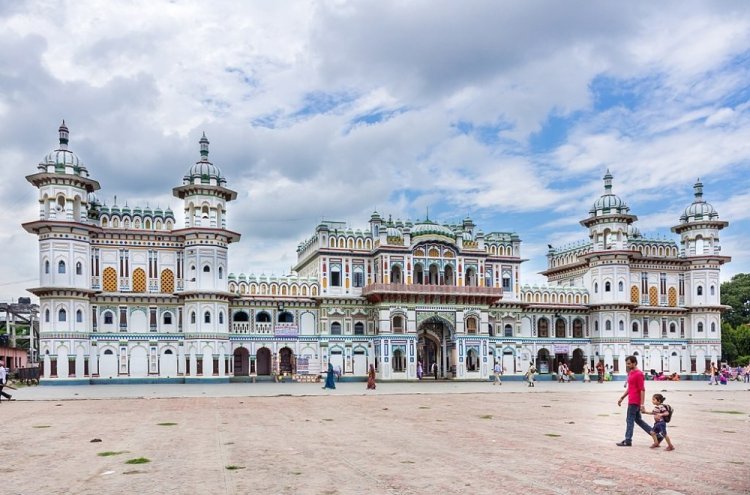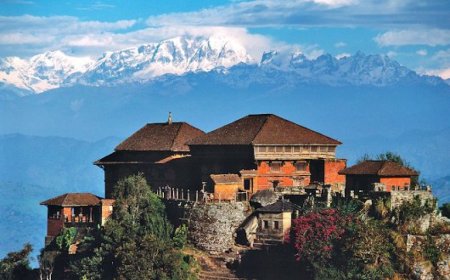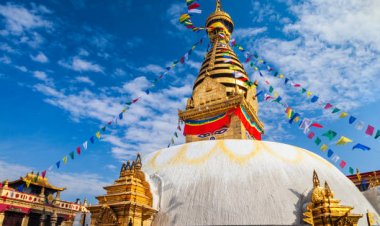Janaki Mandir: Sacred Hindu Temple in Janakpur
Explore Janaki Mandir, a sacred Hindu temple in Janakpur, Nepal. Experience the serenity and devotion at this revered place of worship.

Janaki Mandir, situated in the enchanting city of Janakpur in Nepal, is a highly revered Hindu temple dedicated to Goddess Sita. With its deep spiritual significance, architectural splendor, and historical importance, Janaki Mandir attracts thousands of devotees and tourists from around the world. Let us delve into the captivating aspects of this sacred temple and explore its profound significance.
-
The Historical and Cultural Significance of Janaki Mandir:
- Janaki Mandir holds immense historical and cultural importance as it is believed to be the birthplace of Goddess Sita, the consort of Lord Rama, according to Hindu mythology.
- The temple derives its name from King Janak, who ruled the region and was also the father of Goddess Sita. It stands as a testament to the rich heritage and legacy of the ancient city of Janakpur.
- The temple complex encompasses not only the main shrine but also about 70 smaller temples dedicated to various deities, making it a significant religious site for Hindus worldwide.
- Janaki Mandir has become one of the most prominent pilgrimage destinations for devotees seeking blessings and spiritual solace.
-
Architectural Marvel and Design:
- Janaki Mandir is a true architectural masterpiece, showcasing the exquisite Rajput architecture of Nepal. Its grandeur and intricate craftsmanship mesmerize visitors from all walks of life.
- The three-storied structure is constructed entirely with stone and marble, spanning an area of approximately 4860 square feet. The bright white color of the temple adds to its ethereal beauty.
- Rising 50 meters above the ground, the temple boasts 60 rooms adorned with colored glass, elegant paintings, and intricate engravings. These elements reflect the classic blend of classical and neo-classical designs.
- The main shrine of the temple houses the sacred scriptures of Goddess Sita, Lord Rama, and Lord Lakshmana. The interior of the temple exudes a sense of tranquility and devotion.
-
The Mythological Connection:
- According to legends, the golden statue of Goddess Sita was discovered in 1657 AD by Sannyasi Shurkishordas, the founder of modern Janakpur and a renowned poet. This discovery further solidified the city's association with Goddess Sita.
- Janaki Mandir is built on the exact spot where the golden statue was found, and it is believed to be the place where Goddess Sita resided during her time on Earth. This sacred spot holds deep spiritual significance for devotees.
- The temple also holds historical importance, as it is believed that King Janak performed the worship of Shiva-Dhanus at this very site. This adds to the temple's sanctity and attracts devotees seeking divine blessings.
-
Location and Surroundings:
- Janaki Mandir is situated in Janakpurdham, in the Dhanusa district of Nepal's Terai region. This picturesque location in the Mithila region enhances the temple's charm and spiritual aura.
- The temple lies approximately 225 kilometers southeast of the Kathmandu valley, making it easily accessible for devotees and tourists.
- The surroundings of Janaki Mandir are adorned with about 115 ancient ponds, each holding historical and mythological significance. These ponds add to the serene ambiance and offer a place for devotees to reflect and meditate.
- Visitors can also witness the lush beauty of mango orchards nearby, further enhancing the overall spiritual experience and providing a tranquil retreat.
-
Pilgrimage and Festivals:
- Janaki Mandir holds immense significance as a renowned pilgrimage site, attracting thousands of devotees from Nepal, India, Sri Lanka, and other countries. Pilgrims visit the temple to offer their prayers, seek blessings, and immerse themselves in the divine atmosphere.
- Vivah Panchami, an annual festival celebrating the divine union of Goddess Sita and Lord Rama, draws large crowds of devotees during the months of November and December. The festivities during this time are vibrant and joyous, reflecting the sacred bond between the divine couple.
- Other important festivals celebrated at Janaki Mandir include Ram Navami, Dashain, Tihar, and Chhath. These festivals provide devotees with an opportunity to participate in sacred rituals, witness colorful processions, and experience the rich cultural heritage of the region.
In conclusion, Janaki Mandir, the sacred Hindu temple in Janakpur, Nepal, stands as a testament to the profound spirituality, rich history, and architectural brilliance of the region. Its association with Goddess Sita, the mesmerizing architecture, and the annual festivities make it a significant pilgrimage destination for devotees and a captivating attraction for tourists. A visit to Janaki Mandir not only offers an opportunity to explore the architectural grandeur and historical legacy but also allows one to immerse themselves in the divine aura and seek spiritual solace.
Frequently Asked Questions (FAQ)
-
What is Janaki Mandir?
Janaki Mandir is a Hindu temple located in Janakpur, Nepal, dedicated to Goddess Sita, the consort of Lord Rama.
-
Why is Janaki Mandir significant?
Janaki Mandir holds historical and cultural significance as it is believed to be the birthplace of Goddess Sita and showcases the rich heritage of Janakpur.
-
When was Janaki Mandir built?
Janaki Mandir was built in 1910 AD by Queen Vrisha Bhanu Devi of the Indian state of Tikamgarh. The temple was constructed at a cost of Rupees Nine Lakh (Nine Hundred Thousand) and is also renowned as 'Naulakha Mandir'. -
What is the architectural style of Janaki Mandir?
Janaki Mandir is an architectural marvel with a blend of Rajput, Mughal, and Koiri domes, featuring intricate designs, colored glass, and engravings.
-
What is the mythological connection of Janaki Mandir?
According to legends, the golden statue of Goddess Sita was discovered at the same spot where Janaki Mandir stands today. It is also believed that King Janak performed the worship of Shiva-Dhanus at this site.
-
Where is Janaki Mandir located?
Janaki Mandir is situated in Janakpurdham, in the Dhanusa district of Nepal's Terai region. It is approximately 225 kilometers southeast of the Kathmandu valley.
-
Are there any other temples within the Janaki Mandir complex?
Yes, the Janaki Mandir complex houses about 70 smaller temples dedicated to various deities, making it a significant religious site for Hindus.
-
What are the main festivals celebrated at Janaki Mandir?
The main festivals celebrated at Janaki Mandir include Vivah Panchami, Ram Navami, Dashain, Tihar, and Chhath, attracting a large number of devotees.
-
Can non-Hindus visit Janaki Mandir?
Yes, Janaki Mandir welcomes visitors of all religions to explore its architectural beauty, learn about Hindu mythology, and experience the spiritual ambiance.
-
Are there any historical ponds near Janaki Mandir?
Yes, there are approximately 115 ancient ponds in the vicinity of Janaki Mandir, each holding historical and mythological significance.
-
What is the best time to visit Janaki Mandir?
The temple is visited by a significant number of devotees during the months of November and December for the Vivah Panchami festival. However, visitors can explore Janaki Mandir throughout the year, enjoying its spiritual atmosphere and cultural heritage.
What's Your Reaction?








































































































